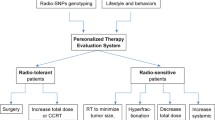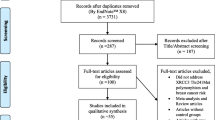Abstract
Radiotherapy is an important weapon in the treatment of breast cancer, but normal tissue injury after radiotherapy can be a threat for patients. Genetic markers conferring the ability to identify hyper-sensitive patients at risk of normal tissue injury in advance would considerably improve therapy. Association studies on genetic variation and occurrence of normal tissue injury can help us identify such markers, but previous studies on the association between XRCC1 R399Q polymorphism and risk of normal tissue injury after radiotherapy in breast cancer patients report conflicting findings. We performed a meta-analysis to comprehensively evaluate the association between XRCC1 R399Q polymorphism and risk of normal tissue injury after radiotherapy in breast cancer patients. The pooled odds ratios (ORs) with their 95 % confidence interval (95 % CIs) were calculated to assess the strength of the association. Fourteen case–control studies with a total of 2,448 breast cancer cases were finally included into the meta-analysis. Overall, XRCC1 R399Q polymorphism was significantly associated with increased risk of normal tissue injury after radiotherapy under all three models (for QQ versus RR: fixed-effects OR = 1.06, 95 % CI 1.00–1.13, P = 0.050; for RQ versus RR: fixed-effects OR = 1.05, 95 % CI 1.00–1.10, P = 0.047; for QQ/RQ versus RR: fixed-effects OR = 1.26, 95 % CI 1.01–1.58, P = 0.041). The meta-analysis suggests that XRCC1 R399Q polymorphism was significantly associated with increased risk of normal tissue injury after radiotherapy in breast cancer patients, and XRCC1 R399Q polymorphism is a genetic marker of normal tissue injury after radiotherapy in breast cancer patients.



Similar content being viewed by others
References
Bertos NR, Park M. Breast cancer—one term, many entities? J Clin Invest. 2011;121:3789–96.
Warner E. Clinical practice. Breast-cancer screening. N Engl J Med. 2011;365:1025–32.
Balduzzi A, Leonardi MC, Cardillo A, Orecchia R, Dellapasqua S, Iorfida M, et al. Timing of adjuvant systemic therapy and radiotherapy after breast-conserving surgery and mastectomy. Cancer Treat Rev. 2010;36:443–50.
Recht A, Solin LJ. Breast-conserving surgery and radiotherapy in early-stage breast cancer: The importance of local control. Semin Radiat Oncol. 2011;21:3–9.
Andratschke N, Maurer J, Molls M, Trott KR. Late radiation-induced heart disease after radiotherapy. Clinical importance, radiobiological mechanisms and strategies of prevention. Radiother Oncol. 2011;100:160–6.
Nagasubramanian R, Innocenti F, Ratain MJ. Pharmacogenetics in cancer treatment. Annu Rev Med. 2003;54:437–52.
Horton JK, Watson M, Stefanick DF, Shaughnessy DT, Taylor JA, Wilson SH. Xrcc1 and DNA polymerase beta in cellular protection against cytotoxic DNA single-strand breaks. Cell Res. 2008;18:48–63.
Andreassen CN, Alsner J, Overgaard M, Overgaard J. Prediction of normal tissue radiosensitivity from polymorphisms in candidate genes. Radiother Oncol. 2003;69:127–35.
Chang-Claude J, Popanda O, Tan XL, Kropp S, Helmbold I, von Fournier D, et al. Association between polymorphisms in the DNA repair genes, XRCC1, APE1, and XPD and acute side effects of radiotherapy in breast cancer patients. Clin Cancer Res. 2005;11:4802–9.
Andreassen CN, Alsner J, Overgaard M, Sorensen FB, Overgaard J. Risk of radiation-induced subcutaneous fibrosis in relation to single nucleotide polymorphisms in TGFB1, SOD2, XRCC1, XRCC3, APEX and ATM—a study based on DNA from formalin fixed paraffin embedded tissue samples. Int J Radiat Biol. 2006;82:577–86.
Chang-Claude J, Ambrosone CB, Lilla C, Kropp S, Helmbold I, von Fournier D, et al. Genetic polymorphisms in DNA repair and damage response genes and late normal tissue complications of radiotherapy for breast cancer. Br J Cancer. 2009;100:1680–6.
Zschenker O, Raabe A, Boeckelmann IK, Borstelmann S, Szymczak S, Wellek S, et al. Association of single nucleotide polymorphisms in ATM, GSTP1, SOD2, TGFB1, XPD and XRCC1 with clinical and cellular radiosensitivity. Radiother Oncol. 2010;97:26–32.
Mangoni M, Bisanzi S, Carozzi F, Sani C, Biti G, Livi L, et al. Association between genetic polymorphisms in the XRCC1, XRCC3, XPD, GSTM1, GSTT1, MSH2, MLH1, MSH3, and MGMT genes and radiosensitivity in breast cancer patients. Int J Radiat Oncol Biol Phys. 2011;81:52–8.
Falvo E, Strigari L, Citro G, Giordano C, Boboc G, Fabretti F, et al. Snps in DNA repair or oxidative stress genes and late subcutaneous fibrosis in patients following single shot partial breast irradiation. J Exp Clin Cancer Res. 2012;31:7.
Raabe A, Derda K, Reuther S, Szymczak S, Borgmann K, Hoeller U, et al. Association of single nucleotide polymorphisms in the genes ATM, GSTP1, SOD2, TGFB1, XPD and XRCC1 with risk of severe erythema after breast conserving radiotherapy. Radiat Oncol. 2012;7:65.
Terrazzino S, La Mattina P, Gambaro G, Masini L, Franco P, Canonico PL, et al. Common variants of GSTP1, GSTA1, and TGFBETA1 are associated with the risk of radiation-induced fibrosis in breast cancer patients. Int J Radiat Oncol Biol Phys. 2012;83:504–11.
Terrazzino S, La Mattina P, Masini L, Caltavuturo T, Gambaro G, Canonico PL, et al. Common variants of eNOS and XRCC1 genes may predict acute skin toxicity in breast cancer patients receiving radiotherapy after breast conserving surgery. Radiother Oncol. 2012;103:199–205.
Higgins J, Thompson SG. Quantifying heterogeneity in a meta-analysis. Stat Med. 2002;21:1539–58.
Doubilet P, Weinstein MC, McNeil BJ. Use and misuse of the term “cost effective” in medicine. N Engl J Med. 1986;314:253–6.
Mantel N, Haenszel W. Statistical aspects of the analysis of data from retrospective studies of disease. J Natl Cancer Inst. 1959;22:719–48.
Egger M, Davey Smith G, Schneider M, Minder C. Bias in meta-analysis detected by a simple, graphical test. BMJ. 1997;315:629–34.
Moullan N, Cox DG, Angele S, Romestaing P, Gerard JP, Hall J. Polymorphisms in the DNA repair gene xrcc1, breast cancer risk, and response to radiotherapy. Cancer Epidemiol Biomark Prev. 2003;12:1168–74.
Giotopoulos G, Symonds RP, Foweraker K, Griffin M, Peat I, Osman A, et al. The late radiotherapy normal tissue injury phenotypes of telangiectasia, fibrosis and atrophy in breast cancer patients have distinct genotype-dependent causes. Br J Cancer. 2007;96:1001–7.
Zhou L, Xia J, Li H, Dai J, Hu Y. Association of xrcc1 variants with acute skin reaction after radiotherapy in breast cancer patients. Cancer Biother Radiopharm. 2010;25:681–5.
Falvo E, Strigari L, Citro G, Giordano C, Arcangeli S, Soriani A, et al. Dose and polymorphic genes xrcc1, xrcc3, gst play a role in the risk of articledeveloping erythema in breast cancer patients following single shot partial breast irradiation after conservative surgery. BMC Cancer. 2011;11:291.
Huang Y, Li L, Yu L. XRCC1 arg399gln, arg194trp and arg280his polymorphisms in breast cancer risk: a meta-analysis. Mutagenesis. 2009;24:331–9.
Saadat M. Haplotype analysis of XRCC1 (at codons 194 and 399) and susceptibility to breast cancer, a meta-analysis of the literatures. Breast Cancer Res Treat. 2010;124:785–91.
Sultana R, Abdel-Fatah T, Abbotts R, Hawkes C, Albarakati N, Seedhouse C, et al. Targeting xrcc1 deficiency in breast cancer for personalized therapy. Cancer Res. 2013;73:1621–34.
Acknowledgments
We thank all the persons who give the help for the study.
Conflicts of interest
None.
Author information
Authors and Affiliations
Corresponding author
Additional information
Y. Zhou and W. Zhou contributed equally to the work.
Rights and permissions
About this article
Cite this article
Zhou, Y., Zhou, W., Liu, Q. et al. XRCC1 R399Q polymorphism and risk of normal tissue injury after radiotherapy in breast cancer patients. Tumor Biol. 35, 21–25 (2014). https://doi.org/10.1007/s13277-013-0990-x
Received:
Accepted:
Published:
Issue Date:
DOI: https://doi.org/10.1007/s13277-013-0990-x




